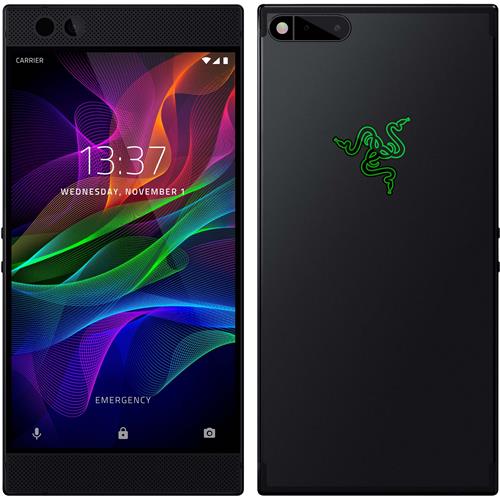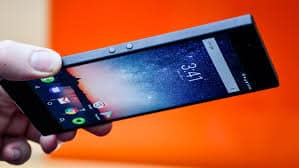it is always exciting for most people to see the face of a newly introduced smartphone, especially one that has been able to gain the interest and respect of gamers.

It is not mandatory for you to like the Razer phone or the style of their company after all the “PC master race” audience is one of the hardest to please. Yet, Razer has managed to please them and has ended up making a name for themselves.
The Razer Phone which was announced on November 2017 is one the first smartphone that is courageous enough to bring along with it a high refresh rate screen into the android market. The 120HZ IGZO screen is one of the most exciting features, but the rest of its features is a typical 2017 flagship specs.
Design
The Razer Phone comes with a 5.7″ IGZO IPS Ultramotion LCD screen with a 1,440×2,560px resolution (16:9); wide color gamut, and a 120Hz refresh rate.
The front of the device has a Gorilla Glass 3, which most people think is outdated, but from our past experience that is still one of the best choices out there when it boils down to scratch protection.
At the bottom and top are the bezels and the dual front-facing speakers, with fine holes that are likely to collect dirt and dust. Also, at the top is a notification LED.
The sides of this device are decorated with appealing brushed black metal all around it and it looks and feels like an extension of one of the company’s stylish laptops and it’s quite amazing.
You will find a pair of controls by the right side of this phone. While at the top of this device is seated a tray for both a single nano SIM and microSD. And so does the power button, fingerprint scanner combo.
In other to accommodate the fingerprint scanner, the button has a fine gloss finish, which is a little bit glossier than it’s surroundings.
To accommodate the fingerprint sensor, the button has a glass finish. It is slightly glossier than its surroundings, which we actually think works really well as a subtle accent.

Coming to the left side of the Razer Phone is seated two small round button, which is the volume buttons. At the top of the Razer, Phone is a solitary microphone, while at the bottom has a microphone and also contains a USB Type-C port.
At the rear of this device are a stylish matte black metal surface and their logo which has an image of the head of three snakes. Overall the design of the Razor Phone is great, Razer managed to input a unique spin on their new product.
Camera
The Razer Phone houses an 8 MP, f/2.0 for selfies and a dual 12MP cameras at the rear, with one a telephoto f/2.4 lens and the other a wide-angle f/1.7 offering.
The telephoto f/2.4 is an updated version of the camera that is in the Galaxy S7, thus, there’s sure to be some strong shooting pedigree.
Razer company decided to settle for a super-simple camera UI, with no pro mode or manual available. It’s just a straight to the point kind of deal, and it’s not overly impressive. Razer knows that its cameras are not so great and have promised to upgrade it with a software.
Razer CEO, Min-Liang Tan said in one of his tweets “we focused on making it a great camera first, and will be releasing the fancy add-on features with patches.”
So, there are no further details on what these add-ons may include, on a timeline on when they’re expected to land, but it’s worth keeping an eye on. And we will update you as soon as they release the software.
For those of you who have the Razer Phone, you can download a more advanced camera app with nice features from the Play Store.
Razer uses its two lenses to offer a smooth zoom. With just a simple screen pinch, you can zoom in and out, swapping between the two lenses.
The result from the cameras is more like a little hit and miss. In a good light condition, the Razer Phone produces high-quality shots with a good level of detail, nevertheless, the colors tend to look a little muted.
Performance
If you are a fan of Razer products you will know that the company is not a stranger to feature-laden and often bloated software suites powering its PCs. And we thought we were going to see something similar in its latest smartphone, but thankfully it didn’t happen that way.
Thankfully, the Razer Phone runs on the Android 7.1.1 Nougat ROM, topped with a very minimal app package. We are glad to see that Razer inclined itself quickly to the Android realm and also have the benefits of a bloat-free OS performance.
Nevertheless, Razer has a way of staying true to its root and also retain all the designs that their fans are used to, and at the same time maintaining less bloat. And they achieved this through the custom Nova Launcher Premium install, that comes with every Razer smartPhone by default.
With the Nova comes a tremendous amount of UI customization options. There are a lot of things you can possibly tweak in the UX to your liking. By default, the Razer Phone uses a Pixel-Style up swipe gesture to access a vertically scrolling app drawer. But with just a few clicks, we could change that gesture to something that was more important to us. Just like tweaking the transition animations and the appearance of the notification badges.
Since you can change most of the feel and look of the Razer UI, which is entirely up to you, there is no need touring most of its basic controls. Like I already stated, you can set up the app drawer in any fashion that you like it, the same applies for the desktop, optional Google Now pane and gestures.
Minus the customizable color, the notification shade is more like the Vanilla Android affair.
There is one unique feature that seems to stand out and that is the DOLBY. A pair of powerful and potential stereo, front-facing speakers on this device are powered by DOLBY ATMOS technology and certified by THX. DOLBY ATMOS technology threw its own equalizer software into the mix and made complete with custom profiles. Within a matter of seconds, you can sharply switch between these from the DOLBY quick toggle.
Some other part of the Razer Phone UI is stock or will I say nearly so as well. And the app switcher and most parts of the main settings menu are included as well. It even supports Split screen.
Here is another one, the Game Booster which is one of them, which serves as a complementary feature to the resolution and refresh rate adjustment controls, that is in the Display menu. Of cause, they are two separate types of controls, which is there for some reason. Nevertheless, the Game Booster allows you to set resolution, refresh rate for the panel and finally a CPU frequency cap for each app, individually.
The “Razer Preferences” menu only holds a usage statistic reporting toggle. Preferably anticlimactic. While going through the developer menu of this device, we noticed an amazing little on-screen fps counter, that the company Also, browsing through the developer menu of the Razer Phone, we found a nifty little which Razer likely implemented for debugging and gaming performance monitoring.
Battery
The Razer Phone houses a massive 4,000mAh battery that is sure to take through the day with a moderate use. Though the Razer Phone was negatively far from what we have hoped for. The battery endurance rating is not as great we thought and is not quite what the number shows that we see.
Even with the lowered max brightness, it seems that the high refresh rate panel is really extremely power hungry, up to the point where it badly pulled down both of our on-screen examinations (tests). Just seven and half hours of browsing the web, in a 2017 flagship? That’s far from being acceptable, not with a massive battery of such. The main problem is that any time you scroll a page, Razer Phone has to work extra hard in other to push 120 fps to saturate the device panel’s refresh rate.
From our logical conclusion, the new 120Hz, IGZO panel is power hungry.
Other Features
- FM ~ No
- Expandable storage ~ Yes,
- 3.5mm Jack ~ No,
- Colors ~ Black.
Razer Phone Price
The Razer Phone is currently sold for about 750 EUR.
Verdict
Razer Phone is actually one of the most innovative flagship smartphones in the market. Though it may not feature an amazing kind of design, nevertheless, it’s currently the only phone pushing mobile gaming to the forefront.



